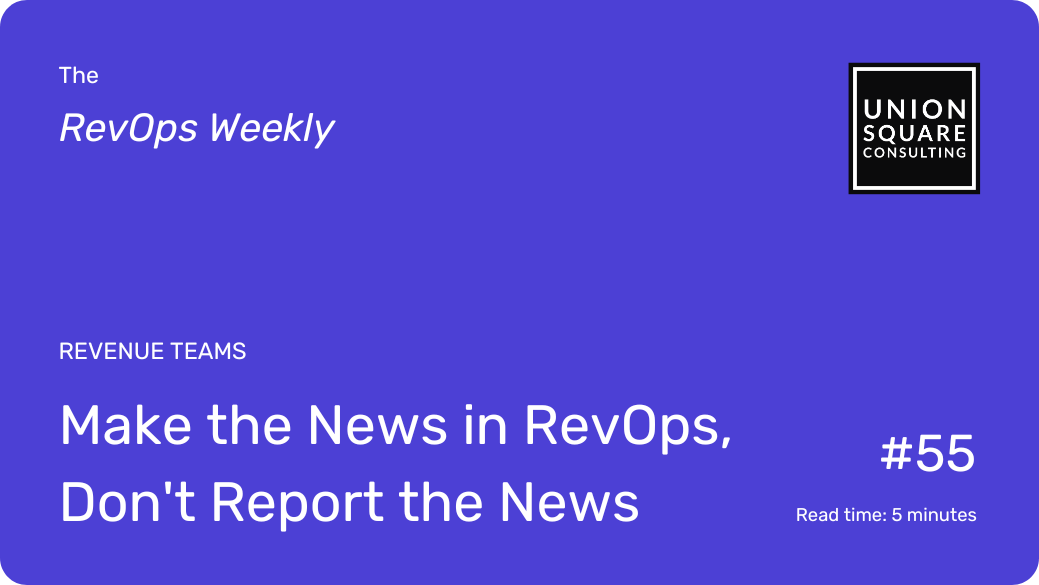
Make the News in RevOps, Don’t Report the News
Read time: 6 minutesExec Summary
- Don’t just present data
- Present insights and opinions
Before presentations, ask:
- What are we analyzing?
- Which KPI is it related to?
- Are we ahead? Behind?
- Impact of the problem?
- What might be the cause?
- What might be a solution?
- Begin a problem solving discourse
This demonstrates your ability to:
- Take insights from data
- Be a strategic advisor
- Prove the value of RevOps
Dear CROs and RevOps pros: What’s a guaranteed way you can make a larger impact in your company?
Moving from systems admin to strategy architect.
Moving from taking tickets to leading projects.
Moving from reporting the news to making the news.
That all sounds great on paper, but how does someone actually do that – with the same amount of time in the day and work on their plate?
Taking on a more strategic role doesn’t have to mean doubling your workload. Today, I’m going to show you a simple exercise and talk track that you can use to turn meeting presentations into proactive problem-solving sessions. And it’ll only take an extra ~1 hour out of your day.
It starts with a mindset shift.
Reporting The News
Reporters give you the facts. They’re known for their steady pace and tone, telling the news without revealing their own emotions and opinions. This is the way news should be conveyed – it allows the listener to collect unbiased information so they can form their own opinions.
Most operators or analysts present data this way when beginning their career.
We may craft a slide with an awesome chart on it (and nothing else). Then, we wait for people to read it, react to it, and talk about it. Just the facts.
So what’s wrong with this situation?
- We’re not putting the data into context
- We’re not offering valuable strategic expertise
- We’re not setting the stage for a good conversation
- We’re not participating in the problem solving process
Maybe we do have a strategic opinion, but we’re not confident enough in our knowledge to share it. We hope that if we just show the facts, others will come to the same conclusion we did, and we don’t have to take the risk of being the first to say it.
Instead, the others attending the meeting are confused about why this data is being shown at all.
Our alternative, as you may have guessed, is to make the news.
Making The News
What is required to “make the news”? Bring an opinion and a plan.
To truly prepare for a meeting, RevOps (and anyone else for that matter) needs to set aside time to analyze the data and form insights around it ahead of time.
This requires blocking your calendar – no way around it. But you don’t have to spend all day on it, either. This exercise can take an hour or less to complete.
Once you have the data for the meeting, you need to outline the following:
- What are we analyzing?
- Which major KPI is this related to?
- Are we performing ahead or behind the plan?
- What would be the impact of missing this plan?
- State what you think the cause of the problem is
- State one option for how to solve the problem or move forward
- Then open it up to the rest of the group
Let’s Do An Example:
Suppose we’re attending a Pipeline Council meeting and RevOps is leading. We show a slide that illustrates that our current quarter forecast and pipeline are on track for targets.
Then, we show a slide that shows our pipeline for the next quarter is not on track. Here’s how I’d tackle the conversation:
1) What are we analyzing: “This slide shows our pipeline for next quarter. Our current progress is $1M against a target of $3M for next quarter. We’re behind pace to hit that $3M in time. “
2) Which KPI is this related to: “As you guys know, this will impact our major KPI of new business bookings for next quarter.”
3) Are we ahead or behind: “We have about 40 more days to increase our pipeline generation rates in order to close the gap.”
4) What is the impact: “If we stay at the same pace, we’ll likely only reach $2.2M for next quarter’s pipeline. This could mean we miss our future revenue targets.”
5) Cause of the problem: “After more examination, I can see the issue is in the enterprise segment. We’re creating about one third of the necessary opportunities in that segment per week.”
6) Suggestion of a solution: “My suggestion is to have a 2nd meeting with our marketers and field reps in the enterprise segment, and brainstorm a one-off campaign that could help us close this gap.”
7) Open it up to the group: “What other ideas are there for beefing up pipeline generation in the next 40 days?”
Proving the Impact of Strategic RevOps
By providing deeper insights beyond the surface-level data, you’re not only showing initiative – you’re demonstrating an ability (and desire) to use the data you’re collecting as a strategic tool for revenue growth.
It’s a lot easier to convince your CXOs to take the health of your systems and processes seriously when you’re able to show the potential impact on their bottom line.
Taking another look at our example above, we can see how important it is to have accurate visibility into our pipeline. Without that visibility, we would not have been able to see the issues forming in our enterprise segment.
And this goes for every other potential revenue leak or pipeline issue, including zombie pipeline.
With your CXOs bought into the value of this work, it’s a lot easier to get a RevOps Roadmap approved and receive air coverage on larger projects.
When you’re ready, here’s how we can help:
Get a Free 1:1 Revenue Efficiency Workshop
Get one of our Senior Revenue Strategists to yourself for 1 hour and leave with a plan to increase the money-making power of your go-to-market operations.
Hire Us!
Bring us on as your Strategic RevOps Team and realize the growth potential of your revenue engine. There are 3 ways to work with us.
Get more tips like these, sent right to your inbox.
Subscribe for fresh, relevant revenue growth tips delivered every week.
